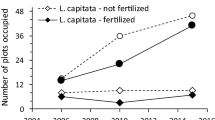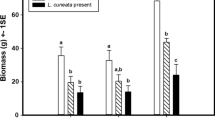Abstract
Invasions by exotic weedy plants frequently occur in highly disturbed or otherwise anthropogenically altered habitats. Here we present evidence that, within California coastal prairie, invasion also can be facilitated by a native nitrogen-fixing shrub, bush lupine (Lupinus arboreus). Bush lupines fix nitrogen and grow rapidly, fertilizing the sandy soil with nitrogen-rich litter. The dense lupine canopy blocks light, restricting vegetative growth under bushes. Heavy insect herbivory kills lupines, opening exposed nitrogen-rich sites within the plant community. Eventual re-establishment of lupine occurs because of an abundant and long-lived seed bank. Lupine germination, rapid growth, shading and fertilization of sites, and then death after only a few years, results in a mosaic of nutrient-rich sites that are available to invading species. To determine the role of bush lupine death and nitrogen enrichment in community composition, we examined nutrient dynamics and plant community characteristics within a site only recently colonized by lupine, comparing patches where lupines had recently died or were experimentally killed with adjacent areas lacking lupine. In experimentally killed patches, instantaneous pool sizes of exchangeable ammonium and nitrate nitrogen were higher than in adjacent sites free of lupine. Seedlings of the introduced grass Bromus diandrus accumulated 48% greater root biomass and 93% more shoot biomass when grown in a greenhouse in soil collected under experimentally killed lupines compared to B. diandrus seedlings grown in soil collected at least 1 m away from lupines. At the end of the spring growing season, total above-ground live plant biomass was more than twice as great in dead lupine patches as in the adjacent lupine-free grassland, but dead lupine patches contained 47% fewer plant species and 57% fewer native species. Sites where lupines have repeatedly died and reestablished during recent decades support an interstitial grassland community high in productivity but low in diversity, composed of mostly weedy introduced annual plants. In contrast, at a site only recently colonized by bush lupines, the interstitial grassland consists of a less productive but more diverse set of native and introduced species. We suggest that repeated bouts of lupine germination, establishment, and death can convert a rich native plant community into a less diverse collection of introduced weeds.
Similar content being viewed by others
References
Aerts R, Berendse F (1988) The effect of increased nutrient availability on vegetation dynamics in wet heathlands. Vegetatio 76:63–69
Alpert P, Mooney HA (in press) Resource heterogeneity generated by shrubs and topography on coastal sand dunes. Vegetatio
Baker JH (1986) Patterns of plant invasions in North America. In: Mooney HA, Drake JA (eds) Ecology of biological invasions of North America and Hawaii. Springer, Berlin Heidelberg New York, pp 44–57
Baker TG, Oliver GR, Hodgkiss PD (1986) Distribution and cycling of nutrients in Pinus radiata as affected by past lupin growth and fertiliser. For Ecol Manage 17:169–187
Barbour MG, Craig RB, Drysdale RR, Ghiselin MT (1973) Coastal ecology of Bodega Head. University of California Press, Berkeley
Bentley BL, Johnson ND (1991) Plants as food for herbivores: the roles of nitrogen fixation and carbon dioxide enrichment. In: Price PW, Lewinsohn TM, Fernandes GW, Benson WW (eds) Plant-animal interactions: evolutionary ecology in tropical and temperate regions. Wiley, New York, pp 257–272
Bobbink R (1991) Effects of nutrient enrichment in Dutch chalk grassland. J Appl Ecol 28:28–41
Bobbink R, Willems JH (1987) Increased dominance of Brachypodium pinnatum (L.) Beauv. in chalk grasslands: a threat to a species-rich ecosystem. Biol Conserv 40:301–314
Breytenbach GJ (1986) Impacts of alien organisms on terrestrial communities with emphasis on communities of the south-western Cape. In: MacDonald IAW, Kruger FJ, Ferrar AA (eds) The ecology and management of biological invasions in Southern Africa. Oxford University Press, Cape Town, pp 229–238
Bridgewater PB, Backshall DJ (1981) Dynamics of some Western Australian ligneous formations with special reference to the invasion of exotic species. Vegetatio 46:141–148
Bruce PC (1991) Resampling stats. Probability and statistics a radically different way. Users guide for IBM version 3.14. Resampling Stats, Arlington, Virginia
Caldwell MM, Eissenstat DM, Richards JH, Allen MF (1985) Competition for phosphorus: differential uptake from dual isotope-labeled soil interspaces between shrub and grass. Science 229:384–386
Carlson RM (1986) Continuous flow reduction of nitrate to ammonia with granular zinc. Anal Chem 58:1590–1591
Crawley MJ (1986) The population biology of invaders. Philos Trans R Soc Lond 314:711–731
D'Antonio CM, Vitousek PM (1992) Biological invasions by exotic grasses, the grass/fire cycle, and global change. Annu Rev Ecol Syst 23:63–87
Davidson ED (1975) Demography of Lupinus arboreus at Bodega Head, California. Ph. D. thesis University of California, Davis
Del Moral R, Bliss LC (1993) Mechanisms of primary succession: insights resulting from the eruption of Mount St Helens. Adv Ecol Res 24:1–66
Drake JA, Mooney HA, Castri F di, Groves RH, Kruger FJ, Rejmanek M, Williamson M (1989) Ecology of biological invasions: a global perspective. Wiley, Chichester
Gadgil RL (1971) The nutritional role of Lupinus arboreus in coastal sand dune forestry. 3. Nitrogen distribution in the ecosystem before tree planting. Plant and Soil 35:113–126
Heddle EM, Specht RL (1975) Dark Island Heath (Ninety-Mile Plain, South Australia). VIII. The effects of fertilizers on composition and growth. Aust J Bot 23:151–164
Heil GW, Diemont WH (1983) Raised nutrient levels change heathland into grassland. Vegetatio 53:113–120
Hengelveld R (1989) Dynamics of biological invasions. Chapman and Hall, London
Hobbs RJ, Huenneke LF (1992) Disturbance, diversity, and invasion: implications for conservation. Conserv Biol 6:324–337
Hobbs RJ, Gulman SL, Hobbs VJ, Mooney HA (1988) Effects of fertilizer addition and subsequent gopher disturbance on a serpentine annual grassland community. Oecologia 75:291–295
Huenneke LF, Hamburg SP, Koide R, Mooney HA, Vitousek PM (1990) Effects of soil resources on plant invasion and community structure in Californian serpentine grassland. Ecology 71:478–491
MacDonald IAW, Loope LL, Usher MB, Hamann O (1989) Wildlife conservation and the invasion of nature preserves by introduced species: a global perspective. In: Drake JA, Mooney HA, Di Castri F, Groves RH, Kruger FJ, Rejmanck M, Williamson M (eds) Ecology of biological invasions: a global perspective. Wiley, Chichester, pp 215–255
Marrs RH (1993) Soil fertility and nature conservation in Europe: theoretical considerations and practical management solutions. Adv Ecol Res 24:241–300
Marrs RH, Owen LDL, Roberts RD, Bradshaw AD (1982) Tree lupin (Lupinus arboreus Sims): An ideal nurse crop for land restoration and mmcnity plantings. Arboric J 6:161–174
Mattson WJ, Addy ND (1975) Phytophagous insects as regulators of forest primary production. Science 190:515–522
Molloy BPJ, Partridge TR, Thomas WP (1991) Decline of tree lupin (Lupinus arboreus) on Kaitorete Spit, Canterbury, New Zealand, 1984–1990. N Z J Bot 29:349–352
Mooney HA, Drake HA (1986) Ecology of biological invasions of North America and Hawaii. Springer, Berlin Heidelberg New York
Mooney HA, Di Castri F, Groves RH, Kruger FJ, Rejmanek M, Williamson M (eds) Ecology of biological invasions: a global perspective. Wiley, Chichester, pp 215–255
Muller MM, Rosenberg C, Siltanen H, Wartiovaara T (1981) Fate of glyphosate and its influence on nitrogen-cycling in two Finnish agricultural soils. Bull Environ Contam Toxicol 27: 724–730
Palaniappan VM, Marrs RH, Bradshaw AD (1979) The effect of Lupinus arboreus on the nitrogen status of china clay wastes. J Appl Ecol 16:825–83
Pimentel D (1986) Biological invasions of plants and animals in agriculture and forestry. In: Mooney HA and Drake JA (eds) Ecology of biological invasions of North America and Hawaii. Springer, Berlin Heidelberg New York, pp 149–162
Pitelka LF (1977) Energy allocation in annual and perennial lupines (Lupinus: Leguminosae). Ecology 58:1055–1065
Rejmanek M (1989) Invasibility of plant communities. In: Drake JA, Mooney HA, Castri F di, Groves RH, Kruger FJ, Rejmanek M, Williamson M (eds) Ecology of biological invasions: a global perspective. Wiley, Chichester, pp 369–388
Skeffington RA, Bradshaw AD (1980) Nitrogen fixation by plants grown on reclaimed china clay waste. J Appl Ecol 17:469–477
Smethurst PJ, Turvey ND, Attiwill PM (1986) Effects of Lupinus spp. on soil nutrient availability and the growth of Pinus radiata D. Don seedlings on a sandy podzol in Victoria, Australia. Plant Soil 95:183–190
Sprent JI, Silvester WB (1973) Nitrogen fixation by Lupinus arboreus grown in the open and under different aged stands of Pinus radiata. New Phytol 72:991–1003
Strong DR, Maron JL, Connors PG, Whipple A, Harrison S, Jefferies RL (1995) High mortality, fluctuation in numbers, and heavy subterranean insect herbivory in bush lupine, Lupinus arboreus. Oecologia 104:85–92
Swank WT, Waide JB, Crossley DA, Todd RL (1981) Insect defoliation enhances nitrate export from forest ecosystems. Oecologia 51:297–200
Tilman D (1988) Plant strategies and the dynamics and structure of plant communities. Princeton University Press, Princeton
Vitousek PM (1994) Beyond global warming: ecology and global change. Ecology 75:1861–1876
Vitousek PM, Walker LR (1989) Biological invasion by Myrica faya in Hawaii: Plant demography, nitrogen fixation, ecosystem effects. Ecol Monogr 59:247–265
Vitousek PM, Walker LR, Whiteaker LD, Mueller-Dombois D, Matson PA (1987) Biological invasion by Myrica faya alters ecosystem development in Hawaii. Science 238:802–804
Willis AJ (1963) Braunton Burrows: the effects on the vegetation of the addition of mineral nutrients to the dune soils. J Ecol 51:353–374
Author information
Authors and Affiliations
Corresponding author
Rights and permissions
About this article
Cite this article
Maron, J.L., Connors, P.G. A native nitrogen-fixing shrub facilitates weed invasion. Oecologia 105, 302–312 (1996). https://doi.org/10.1007/BF00328732
Received:
Accepted:
Issue Date:
DOI: https://doi.org/10.1007/BF00328732




